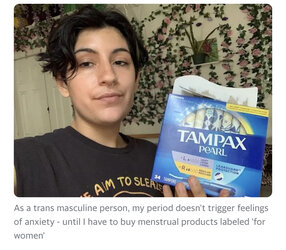Link (Archive)

Gender dysphoria describes the deep anxiety and emotional turmoil many trans people experience when something about their body does not align with their ideal gender presentation. Many things can trigger dysphoria for trans people, and the way we're excluded from conversations around basic bodily functions is one of them.
As a sex and relationships reporter, I get hundreds of pitches a week from companies to review their period products. From period panties to tampons to menstrual cups, my inbox is filled with emails about products marketed as "for her" or "feminine care."
Some days, I can ignore the honest mistake many PR representatives and companies make when trying to sell these products. Other days, I feel like I want to scream and curl up into a ball, in part due to my own dysphoria, but also because I know gendering periods makes it even harder for trans people to access adequate menstrual care.
While I don't have dysphoria about my period itself, it's hard not to feel triggered when I get my period and have to rely on gendered pink products or information. It's an added stress that makes it even harder for me to take care of myself.
According to the 2015 US Trans Survey, one in three trans people have had a negative experience at the doctor, ranging from verbal harassment, to misgendering, to physical trauma. Some trans masculine people are refused care altogetherbecause OB/GYN offices are seen as "women's spaces," the report found.
Before I found my current trans-inclusive clinic in New York City, I had experiences with gynecologists who would misgender me, deadname me, and use extremely gendered language around menstruation, making it feel unsafe to bring up any actual concerns.
The 2015 report also found 28% of trans peopleavoid the doctor because of this kind of mistreatment.
Research suggests gendering periods leads to oversights like universities only putting tampons in women's restrooms, which can leave trans men and trans masculine students unable to access tampons unless they enter a space where they don't feel comfortable. According to a report by the National Center for Transgender Equality, 60% of trans people have avoided public restrooms.
Shifting our language in small ways like saying "people who menstruate" when we talk about who gets a period can be a big step towards making menstruation care trans-inclusive.
Overall, gendering periods perpetuates the harmful myth that your body determines your gender and makes it even more difficult for trans people, like me, to live our lives.
As a trans masculine person, my period doesn't trigger feelings of anxiety - until I have to buy menstrual products labeled 'for women'
Canela López
- I'm a trans masculine reporter who writes about sexual health.
- My period has never made my feel gender dysphoria, but the way periods are framed as "only for women" triggers my anxiety.
- I want more companies to stop gendering bodily functions and make trans-inclusive period products.
Gender dysphoria describes the deep anxiety and emotional turmoil many trans people experience when something about their body does not align with their ideal gender presentation. Many things can trigger dysphoria for trans people, and the way we're excluded from conversations around basic bodily functions is one of them.
As a sex and relationships reporter, I get hundreds of pitches a week from companies to review their period products. From period panties to tampons to menstrual cups, my inbox is filled with emails about products marketed as "for her" or "feminine care."
Some days, I can ignore the honest mistake many PR representatives and companies make when trying to sell these products. Other days, I feel like I want to scream and curl up into a ball, in part due to my own dysphoria, but also because I know gendering periods makes it even harder for trans people to access adequate menstrual care.
While I don't have dysphoria about my period itself, it's hard not to feel triggered when I get my period and have to rely on gendered pink products or information. It's an added stress that makes it even harder for me to take care of myself.
Gendering periods can make it harder for trans people to receive proper medical treatment
The gendering of periods doesn't just make trans people dysphoric - it makes it harder to get the gynecological care we need and deserve.According to the 2015 US Trans Survey, one in three trans people have had a negative experience at the doctor, ranging from verbal harassment, to misgendering, to physical trauma. Some trans masculine people are refused care altogetherbecause OB/GYN offices are seen as "women's spaces," the report found.
Before I found my current trans-inclusive clinic in New York City, I had experiences with gynecologists who would misgender me, deadname me, and use extremely gendered language around menstruation, making it feel unsafe to bring up any actual concerns.
The 2015 report also found 28% of trans peopleavoid the doctor because of this kind of mistreatment.
Research suggests gendering periods leads to oversights like universities only putting tampons in women's restrooms, which can leave trans men and trans masculine students unable to access tampons unless they enter a space where they don't feel comfortable. According to a report by the National Center for Transgender Equality, 60% of trans people have avoided public restrooms.
Shifting our language in small ways like saying "people who menstruate" when we talk about who gets a period can be a big step towards making menstruation care trans-inclusive.
Overall, gendering periods perpetuates the harmful myth that your body determines your gender and makes it even more difficult for trans people, like me, to live our lives.
